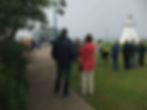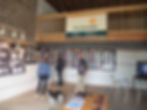
Port Medway History

Getting toes tapping at The History Show in Port Medway.



Fun at The History Show in Port Medway.



Former employees of Teleglobe satellite station that was featured in the 2017 History Show in Port Medway


Every two years, Port Medway hosts a history show - The Medway River History Show - to reflect and educate visitors on its fascinating past. The show is on this year for two weeks from July 14 to July 23. It has grown and will occupy both the Warehouse in Medway Lighthouse Part and in the old Customs House and Chandlery building - Seely Hall just down the street. This year's show, coinciding with Canada's 150th birthday, will have a special focus on the MIll Village Earth Satellite Station which operated from its location in Mill Village from 1963 to 1995.
The south shore of Nova Scotia has been known since the time of Samuel de Champlain. The area was populated by the Mi'kmaq people whose first contact with Europeans was the French. A hunting and fishing culture, they were helpful and friendly toward the French who had no territorial ambitions. What is now known as Port Medway was called Port Maltois by the French while the Mi'kmaq knew the river area as Elacah. Sometime around the mid -18th century the french traders were displaced by Loyalists from Massachusetts who were fishermen, traders and hunters.There is no evidence of a community during the french time but there was perhaps a fort. The newcomers' mispronunciation of the name resulted in the settlement being called Port Metway which evolved into Port Medway over time. There is no connection between the famed Medway River in England and ours.
The migrants from Massachusetts built the first village and they began what became internationally significant logging and fishing industries. Fish (mostly Cod) were shipped to the American states and the Caribbean. The return trip brought sugar, molasses and rum to the south shore. The lumber went everywhere - Europe, the U.S., South America, Africa and China - on sailing ships that set out from the Port Medway docks. What a sight it must have been with full rigged ships, barques, brigantines, coastal schooners and fishing vessels vying for space in a busy harbour. And, not far from the ships were log booms from upriver and mills along the riverside.
In its heyday there were six main wharfs in Port Medway with smaller wharfs upriver toward Mill Village. There was also a boat building industry. One of the boats it produced is the 20 foot lapstrake Port Medway Skiff, a replica of which is in the Marine Museum in Halifax.
Logging was conducted throughout the Medway watershed and boomed downriver to mills - from Charleston to Mill Village to Port Medway.
The lighthouse by the remaining wharfs has been there since 1899. It is the original. Out Long Cove Road is a later lighthouse that has been replaced four times and is now owned by the Port Medway Lighthouse Society. They were built to guide oceanic steamers that came into harbour to load pulp from the mills in Charleston.
Seely Hall near the wharf, which is currently being restored, was once the Customs House and Chandlery.